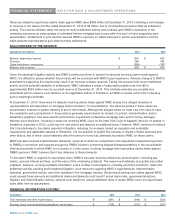GE 2014 Annual Report Download - page 164
Download and view the complete annual report
Please find page 164 of the 2014 GE annual report below. You can navigate through the pages in the report by either clicking on the pages listed below, or by using the keyword search tool below to find specific information within the annual report.
144 GE 2014 FORM 10-K
FINANCIAL STATEMENTS PRESENTATION & POLICIES
GOODWILL AND OTHER INTANGIBLE ASSETS
We do not amortize goodwill, but test it at least annually for impairment at the reporting unit level. A reporting unit is the
operating segment, or one level below that operating segment (the component level) if discrete financial information is
prepared and regularly reviewed by segment management. However, components are aggregated as a single reporting unit if
they have similar economic characteristics. We recognize an impairment charge if the carrying amount of a reporting unit
exceeds its fair value and the carrying amount of the reporting unit’s goodwill exceeds the implied fair value of that goodwill.
We use a market approach, when available and appropriate, or the income approach, or a combination of both to establish fair
values. When a portion of a reporting unit is disposed, goodwill is allocated to the gain or loss on disposition based on the
relative fair values of the business or businesses disposed and the portion of the reporting unit that will be retained.
We amortize the cost of other intangibles over their estimated useful lives unless such lives are deemed indefinite. The cost of
intangible assets is generally amortized on a straight-line basis over the asset’s estimated economic life, except that
individually significant customer-related intangible assets are amortized in relation to total related sales. Amortizable intangible
assets are reviewed for impairment whenever events or changes in circumstances indicate that the related carrying amounts
may not be recoverable. In these circumstances, they are tested for impairment based on undiscounted cash flows and, if
impaired, written down to fair value based on either discounted cash flows or appraised values. Intangible assets with
indefinite lives are tested annually for impairment and written down to fair value as required.
GECC INVESTMENT CONTRACTS, INSURANCE LIABILITIES AND INSURANCE ANNUITY
BENEFITS
Certain entities that we consolidate provide guaranteed investment contracts, primarily to states, municipalities and municipal
authorities.
Our insurance activities include providing insurance and reinsurance for life and health risks and providing certain annuity
products. Two primary product groups are provided: traditional insurance contracts and investment contracts. Insurance
contracts are contracts with significant mortality and/or morbidity risks, while investment contracts are contracts without such
risks.
For short-duration insurance contracts, including accident and health insurance, we report premiums as earned income over
the terms of the related agreements, generally on a pro-rata basis. For traditional long-duration insurance contracts including
long-term care, term, whole life and annuities payable for the life of the annuitant, we report premiums as earned income when
due.
Premiums received on investment contracts (including annuities without significant mortality risk) are not reported as revenues
but rather as deposit liabilities. We recognize revenues for charges and assessments on these contracts, mostly for mortality,
contract initiation, administration and surrender. Amounts credited to policyholder accounts are charged to expense.
Liabilities for traditional long-duration insurance contracts represent the present value of such benefits less the present value
of future net premiums based on mortality, morbidity, interest and other assumptions at the time the policies were issued or
acquired. Liabilities for investment contracts equal the account value, that is, the amount that accrues to the benefit of the
contract or policyholder including credited interest and assessments through the financial statement date. For guaranteed
investment contracts, the liability is also adjusted as a result of fair value hedging activity.
Liabilities for unpaid claims and estimated claim settlement expenses represent our best estimate of the ultimate obligations
for reported and incurred-but-not-reported claims and the related estimated claim settlement expenses. Liabilities for unpaid
claims and estimated claim settlement expenses are continually reviewed and adjusted through current operations.
























